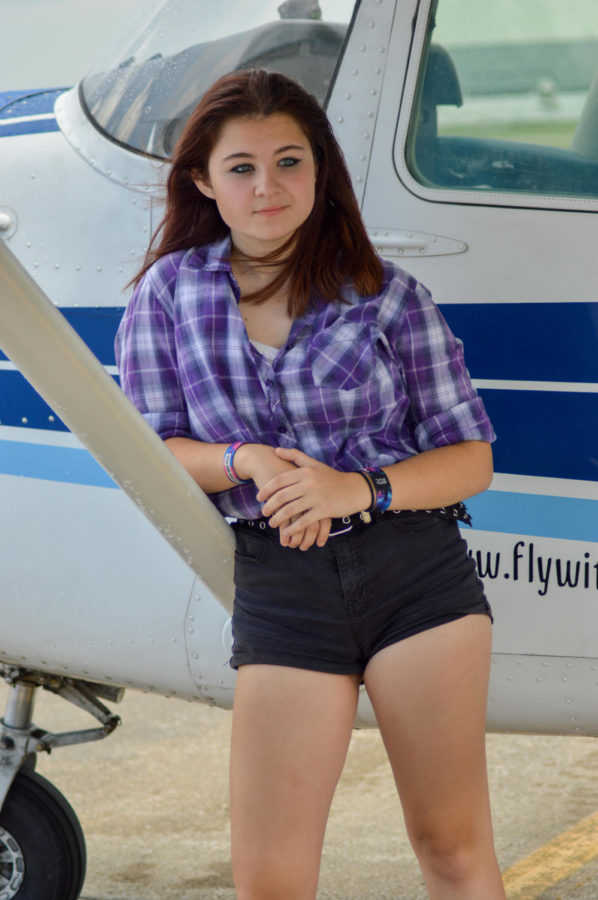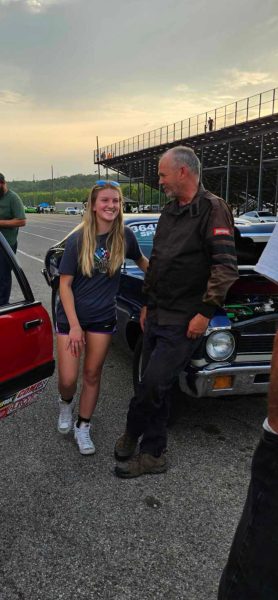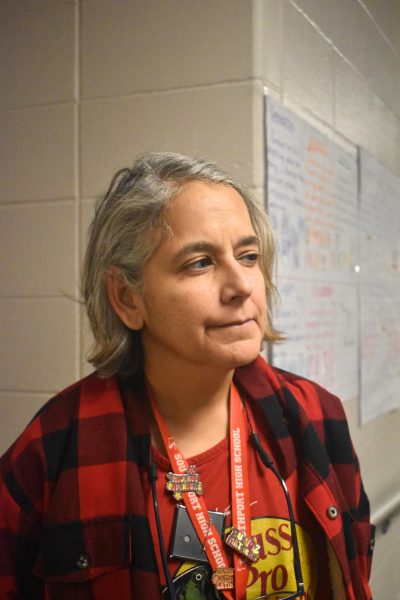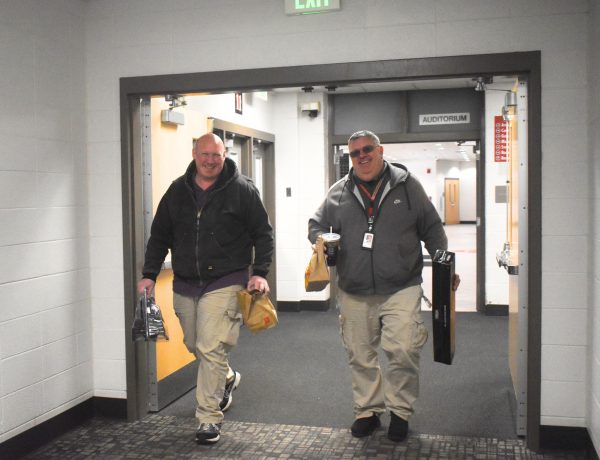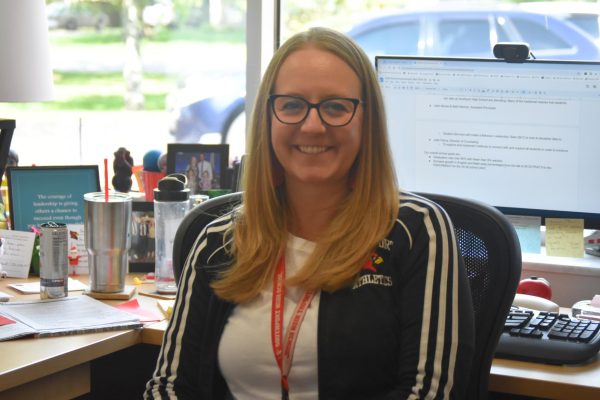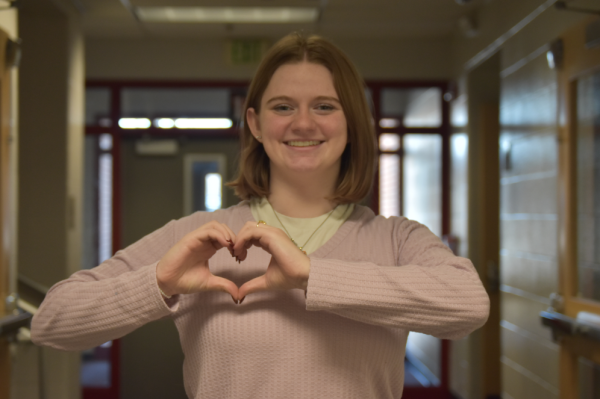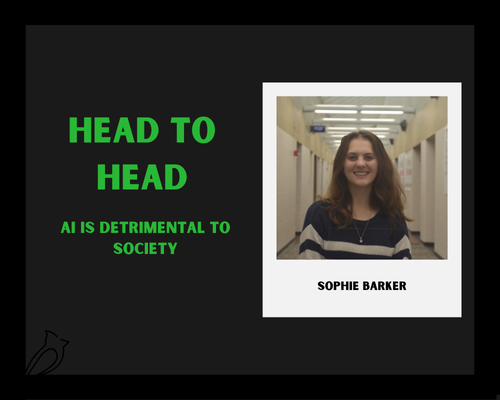Taking flight
Sophomore works to earn her pilot’s license
Sophomore Katie Essex poses in front of one the planes she flies. She hopes to fly without an instructor soon.
Katie Essex sat in the left hand seat of the Cessna 172 airplane with her hands in her lap, watching in total amazement as her instructor guided it off of the ground. It was only her second time in an airplane in her life, and seeing it from the cockpit was exhilarating.
Everything was going according to plan: She was in the plane, seeing the knowledge she had learned in ground school in use.
But that’s where they diverged from the plan. Essex’s flight instructor asked her a simple question.
“Do you want to take control?”
Of course, she did. She put both hands firmly on the yoke and started steering the plane. Everything she had learned in ground school came to life, and she was in control.
“My first flying experience was something that kind of changed my life,” Essex said. “I really knew that this was something that I knew I was going to love and I knew that I could see myself doing.”
Flying has been a part of her life from the beginning, and its impact on her life is immense.
Just as most people grow up wanting to learn to drive, Essex, now a sophomore, grew up wanting to fly.
She was surrounded by flying from a very early age. Her dad worked at an airport, and she had always had a fascination with planes.
“I absolutely loved being around them, seeing what people did,” Essex said.
The seed was planted early, but it wasn’t until last year that she acted on her interest.
Computer science teacher Mark Snodgrass pushed her to pursue aviation after meeting her during student council.
During that meeting, Snodgrass asked her an important question.
“I asked her what she wants to do when she leaves this place,” Snodgrass said. “And she said she wanted to be a pilot. So I said, ‘Let’s go be a pilot.’”
Snodgrass was the perfect person to aid Essex on her journey, given that he has connections to many pilots. His own son flies planes, so he was familiar with the process.
He is currently working on a partnership with Greenwood Airport that will allow students to take night classes to earn their license. These classes would also count for high school graduation credits.
Snodgrass hopes that this partnership will make becoming a pilot more accessible to students.
Essex credits Snodgrass with getting her to apply for ground school at Greenwood Airport.
“He is definitely the person who has sparked a lot of this for me,” Essex said. “Just getting to meet him and learn about what he does and planes, was something that was really important for me.”
Snodgrass, however, remains humble and gives her the credit.
“All I can do is provide the opportunity,” Snodgrass said. “She grabbed it and ran.”
And run she did. She applied for ground school, and eventually got accepted. Ground school is like the flying version of driver’s ed.
It’s where people are taught all of the important background information necessary to fly a plane.
The day after Essex was accepted to ground school, she went to class.
“We walked around the airport and we got to see all the planes and they told us about the structure of the planes, what’s kind of in planes and a little bit about how they fly,” Essex said.
Ground school was not easy. The same course that she took is also offered at C9, but there, it is a two-year class. Her ground school program at Greenwood Airport fit that all into four months, from January to April 2021.
During this time, Essex went to the airport three times a week for two hours. Outside of class, she had to read her textbook and studied all things flying.
During her time in ground school, she was also keeping up with her school work at SHS and had to balance the numerous aspects of her life. Many students struggled to keep up with school work during last year’s COVID-19 environment, and adding in ground school only made it harder.
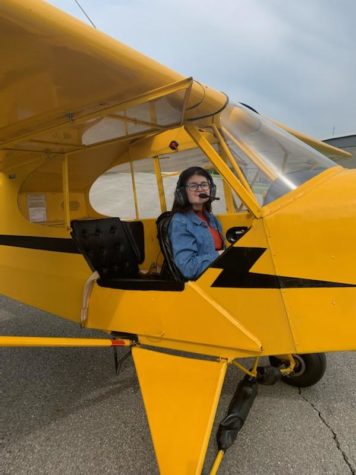
“It was a lot. I’m not gonna lie to you,” Essex said.
But, this busy schedule allowed her to obtain many valuable skills that the majority of people don’t learn until adulthood.
She learned what studying methods worked best for her, how to apply textbook information in the real world and most importantly how mental health fits into a professional life.
“I have begun to learn how to balance a career with regular life, with my mental health,” Essex said. “As you start to get into anything huge, like this is, it’s important to keep your own mental health in mind.”
Even now that Essex is done with ground school, her schedule remains packed. Currently, she goes to the airport two times per week, looking at and talking about different planes with the instructors. This is all part of her preparation for the Federal Aviation Administration Written Exam.
This test consists of 60 questions, taken from a bank of over 750 possible questions. To pass, she must receive 70% or higher.
This test is extremely challenging according to Roger Tomey, Essex’s ground school instructor.
“The questions are not usually easy to understand…,” Tomey said. “You’ve got to read them very carefully. One word can change what the answer is.”
But, he believes that Essex is well prepared for it and will succeed. Passing this exam allows her to start in-air training, the next section of her flying journey.
Normally, flight training is very expensive, at around $200 per hour between the instructor and plane rental. But, she has that taken care of.
Essex applied for, and won, a $10,000 scholarship through Greenwood Airport’s chapter of the Experimental Aircraft Association. They give out a scholarship like this once every two years, and though there were other applicants, she had many qualities that earned her the scholarship.
“What made her stand out was her enthusiasm,” Tomey said. “The way she filled out the application, she was very detailed. In that, she did a great job on the essay.”
This scholarship will cover the cost of the 50 hours of in-plane training that Essex will need to complete in order to get her private pilot license.
After she officially receives the scholarship (which she was scheduled to receive yesterday), she plans to start her training.
This means completing three hours of in-plane training each week. As has been the case with her entire journey, she won’t be wasting any time getting started. Her first flight hour is scheduled for Monday, Sept. 13.
About halfway through her training, she will be able to begin soloing and control the plane unaccompanied from takeoff to landing. If everything goes as planned, she will begin soloing in late November or early December, before she’ll have her driver’s license.
“It’s always been so funny to me thinking about the legalities,” Essex said. “The government will legally allow me to fly a plane before I can drive a car by myself.”
When she reaches the end of her 50 in-plane training hours and turns 17 years old, she will be able to take the checkride, which when passed, will allow her to get her private pilot’s license. This license enables her to fly with passengers, like her friends and family.
While Essex hasn’t completely decided on what she wants to do in the future, she knows that it will be connected to flying.
“I want to double major in aerospace or aeronautical engineering as well as aviation because that’ll build up flight hours through the aviation degree,” Essex said.
Right now, she thinks that she either wants to become an Airline Transport Pilot, flying passengers commercially, or go into the Air Force, protecting U.S. citizens by flying in high risk situations.
But, whatever she ends up doing, she knows one thing for sure. Essex wants her life to leave an impact. When she was younger, she wasn’t sure how this would play out. But now, it’s clear. Flying.
“I had always grown up and wondered, what was my passion? Where was I gonna fit into the world? And then there was flying,” Essex said. “And now I can’t see myself doing anything else.”
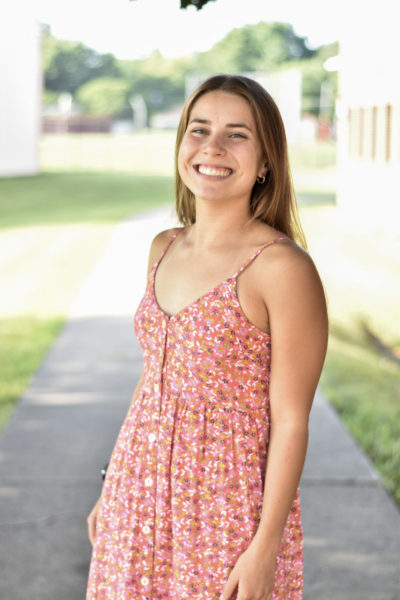
Howdy! My name is Lucy Hiller, and I’m a senior this year (whoop whoop), so I’m savoring every last second I get at SHS. For my third year on The Journal,...


